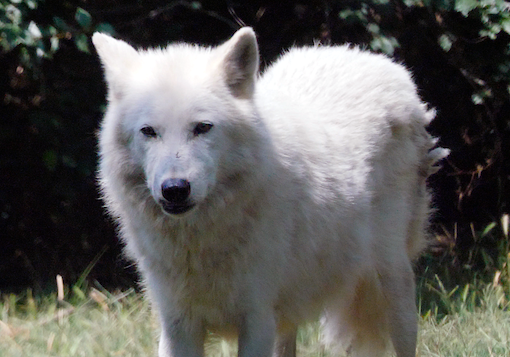Wildlife watching in West Macedonia
- Green Traveller

- Oct 1, 2022
- 5 min read
Updated: Oct 16, 2022
Sarah Baxter sees bears, lynx and wolves and an array of other wildlife as she crosses West Macedonia
Photos from top left: wolf, bear, lynx and wolf. Photos: Richard Hammond
Greece: a land of 227 islands, innumerable beaches, ouzo and tzatziki, ancient ruins. Oh, and around 700 bears. No one tell you about the bears? Well then, if you go down to the Greek woods today, you’re sure of a big surprise…
Particularly the woods of western Macedonia, one of the country’s least-trodden regions but one of its most biodiverse. “People don’t know about mountainous Greece,” field biologist Lampros Krampokoukis told me as we walked in the foothills of the Vitsi range. “But wildlife is abundant here – birds, reptiles, wolves, bears.”
Lampros works for Arcturos, a non-profit organisation, based just outside the charming hillside village of Nymfaio, that is dedicated to rescuing captive animals, protecting habitats and educating the public.
“My parents took me to see a dancing bear when I was six and I burst into tears,” Lampros told me. “It sowed the seeds of wanting to work in conservation.”
The Arcturos bear sanctuary is home to around 20 bears that have been confiscated from zoos and private collections, including Barbara, the sanctuary’s last dancing bear – thankfully this barbaric practice is now illegal in most countries. Too accustomed to humans, these animals cannot be released into the wild but at least get to live out their days in large, natural enclosures. It’s brilliant for the bears, and a joy for visitors like me – with Lampros, I walked the perimeter, gaining glimpses of these powerful creatures doing what they do: rubbing against trees, sniffing out food, exchanging bone-trembling roars.
Close by, Arcturos also runs a sanctuary for lynx and wolves, where I was similarly lucky to see some of the rescued residents. In one enclosure a lone grey wolf emerged from a thicket and sniffed the air before turning in our direction, holding us briefly in its unnerving stare. In the next-door pen, a lynx sat statuesque, bold as brass, right by the fence; a tortoise crawled around her huge paws but she didn’t bat a whisker.
Lynx are a ghost species in Greece – they’ve been extinct here for 80 years. But there’s hope. “There’s a small population in Albania and North Macedonia, close to the borders, so I am optimistic they will reappear in Greece,” Lampros explained. “The most important thing now is educating people so that when they do return the conditions are right.”
It was exciting to see these charismatic species so close, and to know that ill-treated animals are being looked after – a batch of bears from a substandard zoo in Italy was due to arrive shortly after my visit.
But I was also keen to know more about the wild ones. So the next day, as Nikos helped me into the saddle of one of his tough Pindos horses, I asked if he’d ever seen a bear while out riding. “Three times,” he replied. It was a very long short, but I kept my fingers crossed.
Nikos is a maths teacher by trade but, with his father Dimitris, also runs Artemis Tours, leading trips in the countryside around Sklithro, near the wolf and lynx sanctuary, on foot, bike and horseback. We hacked out from his basecamp cabin in blazing sunshine, the air thick with the sweet scent of tilia trees and freckled with butterflies. We splashed across streams, wound through village streets and galloped across fields. We found healing balsamo, wild mint (which we later brewed up for tea) and a bounty of fruits: cherries, apricots and purple damsons, delicious straight from the trees. We also found loganberries which, apparently, bears love – and a fresh pile of scat nearby proved one hungry ursine had recently been this way. Not a bear sighting, perhaps, but a thrill nonetheless.
I couldn’t forget the wild nature of the region even after swapping horse for car to make the onward journey to Prespa National Park, in Greece’s far north-west. It seemed every corner of the winding road through the forest-cloaked mountains was marked by warning signs for bears, deer or wild boar.
I didn’t see any of those creatures en route but was soon hanging out with some of Prespa’s other residents.
Around 270 bird species have been recorded in the park, and I joined local ranger Amalia for a spot of birdwatching atop Krina Hill. This mound on the western shore of Little Prespa Lake sits above a patch of bird-busy wet meadows and reed islands. Squacco herons mooched among the lily pads, cormorants dried their wings in the sun and Dalmatian pelicans floated like mini sailboats.
I saw a man sorting fat Prespa beans – a local speciality – in a shack at the bottom of the hill and a couple of people strolling over the floating footbridge to the islet of Agios Ahilios, but otherwise all was still; just the occasional beat of feathers. I could have stayed there all evening.
Eventually I tore myself away, but was keen to get back to the water the next morning, this time to the park’s larger Great Prepsa Lake. I arrived early at Syntrofia Tavern in Psarades, though of course owner Germanos had already been up, out on the water and back, and was now sitting on the dock, disentangling tiny tsironi fish from a fine net with his large, agile hands. Only when he was done, and the dock washed down, did he nod my way.
We hopped in his boat and puttered out into Great Prespa Lake, a wide expanse of water shared with North Macedonia and Albania. Germanos navigated along the craggy cliffs, past pelicans and herons, eventually stopping at a little jetty. He motioned for me to jump off – then left.
Alone on the pebble beach, there was only one thing for it: to climb the steps that zig-zagged up the cliff-face ahead. At the top, tucked into the rock, lay a tiny, frescoed chapel: the hermitage of Panagia Eleoussa. Built in the 15th-century, Christian monks once hid from the Ottomans here. And what a spot to choose. Looking out, I could see the lapping blue water and the distant summits – a whole world framed by the cave’s wide maw. But inside it felt secret, a brief sanctuary from the modern world. And we all need a sanctuary sometimes, whether we’re human, bird or bear.
==
With thanks to Joysters for facilitating our visit in the summer of 2022.
For more information about travelling in this part of Northern Greece, see our Green Traveller's Guide to Macedonia and Thessaloniki











Comments